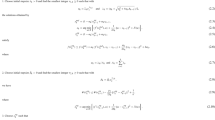Abstract
We study the limiting behavior of the weighted central paths{(x(μ), s(μ))} μ > 0 in linear programming at bothμ = 0 andμ = ∞. We establish the existence of a partition (B ∞,N ∞) of the index set { 1, ⋯,n } such thatx i(μ) → ∞ ands j (μ) → ∞ asμ → ∞ fori ∈ B ∞, andj ∈ N ∞, andx N∞ (μ),s B∞ (μ) converge to weighted analytic centers of certain polytopes. For allk ⩾ 1, we show that thekth order derivativesx (k) (μ) ands (k) (μ) converge whenμ → 0 andμ → ∞. Consequently, the derivatives of each order are bounded in the interval (0, ∞). We calculate the limiting derivatives explicitly, and establish the surprising result that all higher order derivatives (k ⩾ 2) converge to zero whenμ → ∞.
Similar content being viewed by others
References
I. Adler and R.D.C. Monteiro, “Limiting behavior of the affine scaling continuous trajectories for linear programming problems,”Mathematical Programming 50 (1991) 29–51.
K.M. Anstreicher, “Linear programming and the Newton barrier flow,”Mathematical Programming 41 (1988) 363–373.
D.A. Bayer and J.C. Lagarias, “The nonlinear geometry of linear programming, I. affine and projective scaling trajectories, II. Legendre transform coordinates and central trajectories,”Transactions of the American Mathematical Society 314 (1989) 499–581.
A. Ben-Israel and T.N.E. Greville,Generalized Inverses: Theory and Applications (John Wiley and Sons, New York, 1974).
A.V. Fiacco and G.P. McCormick,Nonlinear Programming: Sequential Unconstrained Minimization Techniques (John Wiley and Sons, New York, 1968). Republished by SIAM (Philadelphia) 1990.
A.J. Goldman and A.W. Tucker, “Theory of linear programming,” in: H.W. Kuhn and A.W. Tucker, eds.,Linear Inequalities and Related Systems, Annals of Mathematical Studies 38 (Princeton University Press, Princeton, New Jersey, 1956) pp 53–97.
I.S. Gradshteyn and I.M. Ryzhik,Table of Integrals, Series, and Products, corrected and enlargened edition (Academic Press, New York, 1980).
O. Güler, “Existence of interior points and interior paths in nonlinear monotone complementarity problems,”Mathematics of Operations Research 18 (1993) 128–147.
O. Güler, C. Roos, T. Terlaky and J.-Ph. Vial, “Interior point approach to the theory of linear programming,” Technical Report 1992.3, Faculté des SES, Université de Genève (Genève, Switzerland, 1992).
N. Karmarkar, “A new polynomial-time algorithm for linear programming,”Combinatorica 4 (1984) 373–395.
M. Kojima, S. Mizuno and A. Yoshise, “A polynomial-time algorithm for a class of linear complementarity problems,”Mathematical Programming 44 (1989) 1–26.
M. Kojima, S. Mizuno and A. Yoshise, “An O\((\sqrt {nL} )\) iteration potential reduction algorithm for linear complementarity problem,”Mathematical Programming 50 (1991) 331–342.
L. McLinden, “An analogue of Moreau's proximation theorem, with applications to the nonlinear complementarity problem,”Pacific Journal of Mathematics 88 (1980) 101–161.
L. McLinden, “The complementarity problem for maximal monotone multifunctions,” in: R.W. Cottle, F. Giannessi and J.L. Lions, eds.,Variational Inequalities and Complementarity Problems (John Wiley and Sons, New York, 1980) pp 251–270.
L. McLinden, “Polyhedral extensions of some theorems of linear programming,”Mathematical Programming 22 (1982) 162–176.
N. Megiddo, “Pathways to the optimal set in linear programming,” in: N. Megiddo, ed.,Progress in Mathematical Programming — Interior Point and Related Methods (Springer Verlag, New York, 1989) pp. 131–158.
N. Megiddo and M. Shub, “Boundary behavior of interior point algorithms in linear programming,”Mathematics of Operations Research 14 (1989) 97–146.
S. Mehrotra, “Quadratic convergence in a primal-dual method,”Mathematics of Operations Research 18 (1993) 741–751.
S. Mehrotra, “Asymptotic convergence in the generalized predictor—corrector method,” Technical Report, Department of IE and MS, Northwestern University (Evanston, Illinois, 1992).
S. Mizuno, M.J. Todd and Y. Ye, “On adaptive-step primal-dual interior-point algorithms for linear programming,”Mathematics of Operations Research 18 (1993) 964–981.
R.D.C. Monteiro and I. Adler, “Interior path following primal-dual algorithms. Part I: Linear programming,”Mathematical Programming 44 (1989) 27–42.
Gy. Sonnevend, “An ‘analytic centre’ for polyhedrons and new classes of global algorithms for linear (smooth, convex) programming,” in:Lecture Notes in Control and Information Sciences (Springer Verlag, New York, 1985) pp. 866–876.
A.C. Williams, “Complementarity theorems in linear programming,”SIAM Review 12 (1970) 135–137.
C. Witzgall, P.T. Boggs and P.D. Domich, “On the convergence behavior of trajectories for linear programming,”Contemporary Mathematics 114 (1990) 161–187.
Y. Ye, “AnO(n 3 L) potential reduction algorithm for linear programming,”Mathematical Programming 50 (1991) 239–258.
Y. Ye, O. Güler, R.A. Tapia and Y. Zhang, “A quadratically convergent O\((\sqrt {nL} )\)-iteration algorithm for linear programming,”Mathematical Programming 59 (1993) 151–162.
Author information
Authors and Affiliations
Rights and permissions
About this article
Cite this article
Güler, O. Limiting behavior of weighted central paths in linear programming. Mathematical Programming 65, 347–363 (1994). https://doi.org/10.1007/BF01581702
Received:
Revised:
Issue Date:
DOI: https://doi.org/10.1007/BF01581702
Keywords
- Linear programming
- (Weighted) central paths
- Limiting behavior on central paths
- Local convergence rates of interior point algorithms



